CHRYSLER VOYAGER 1996 Workshop Manual
Manufacturer: CHRYSLER, Model Year: 1996, Model line: VOYAGER, Model: CHRYSLER VOYAGER 1996Pages: 1938, PDF Size: 55.84 MB
Page 51 of 1938
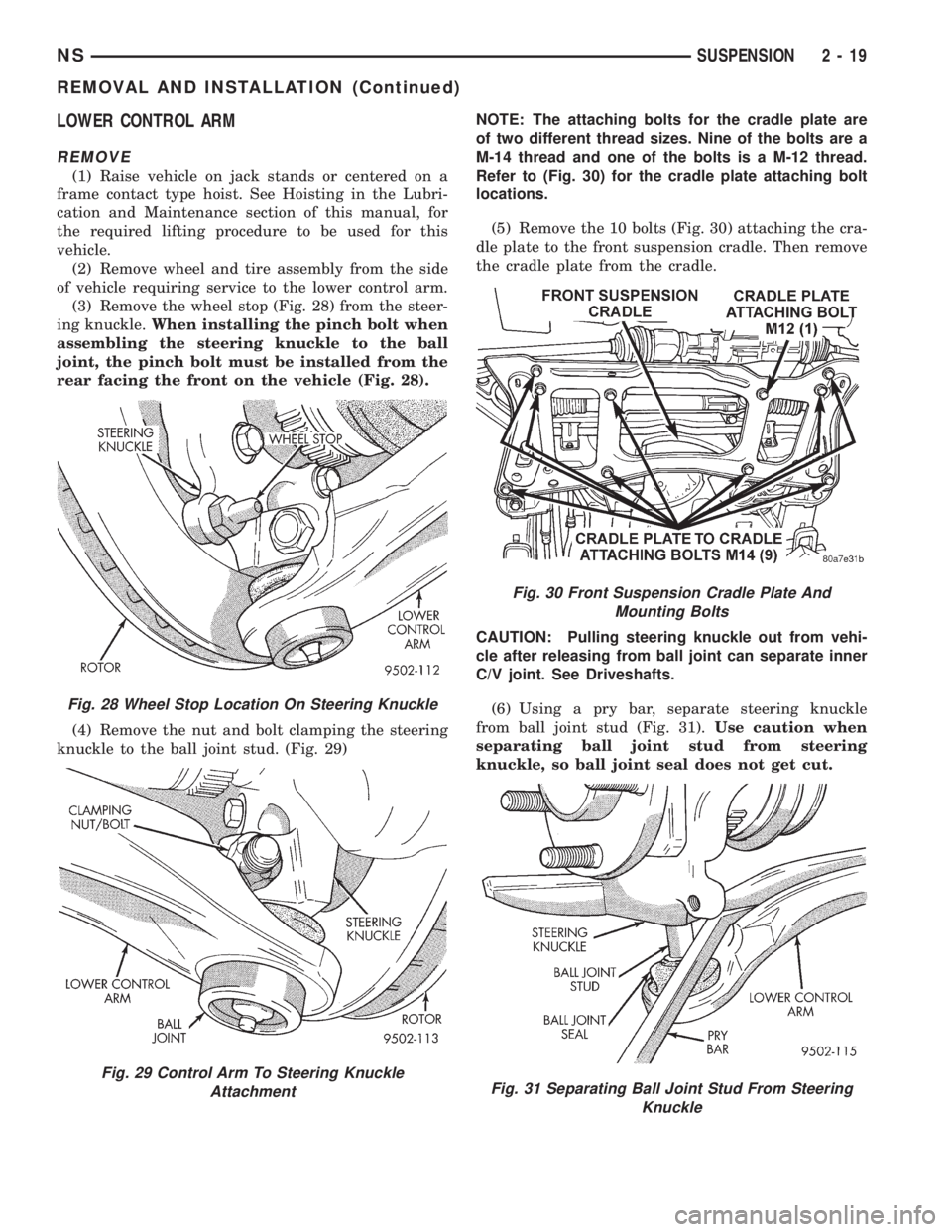
LOWER CONTROL ARM
REMOVE
(1) Raise vehicle on jack stands or centered on a
frame contact type hoist. See Hoisting in the Lubri-
cation and Maintenance section of this manual, for
the required lifting procedure to be used for this
vehicle.
(2) Remove wheel and tire assembly from the side
of vehicle requiring service to the lower control arm.
(3) Remove the wheel stop (Fig. 28) from the steer-
ing knuckle.When installing the pinch bolt when
assembling the steering knuckle to the ball
joint, the pinch bolt must be installed from the
rear facing the front on the vehicle (Fig. 28).
(4) Remove the nut and bolt clamping the steering
knuckle to the ball joint stud. (Fig. 29)NOTE: The attaching bolts for the cradle plate are
of two different thread sizes. Nine of the bolts are a
M-14 thread and one of the bolts is a M-12 thread.
Refer to (Fig. 30) for the cradle plate attaching bolt
locations.
(5) Remove the 10 bolts (Fig. 30) attaching the cra-
dle plate to the front suspension cradle. Then remove
the cradle plate from the cradle.
CAUTION: Pulling steering knuckle out from vehi-
cle after releasing from ball joint can separate inner
C/V joint. See Driveshafts.
(6) Using a pry bar, separate steering knuckle
from ball joint stud (Fig. 31).Use caution when
separating ball joint stud from steering
knuckle, so ball joint seal does not get cut.
Fig. 28 Wheel Stop Location On Steering Knuckle
Fig. 29 Control Arm To Steering Knuckle
Attachment
Fig. 30 Front Suspension Cradle Plate And
Mounting Bolts
Fig. 31 Separating Ball Joint Stud From Steering
Knuckle
NSSUSPENSION 2 - 19
REMOVAL AND INSTALLATION (Continued)
Page 52 of 1938
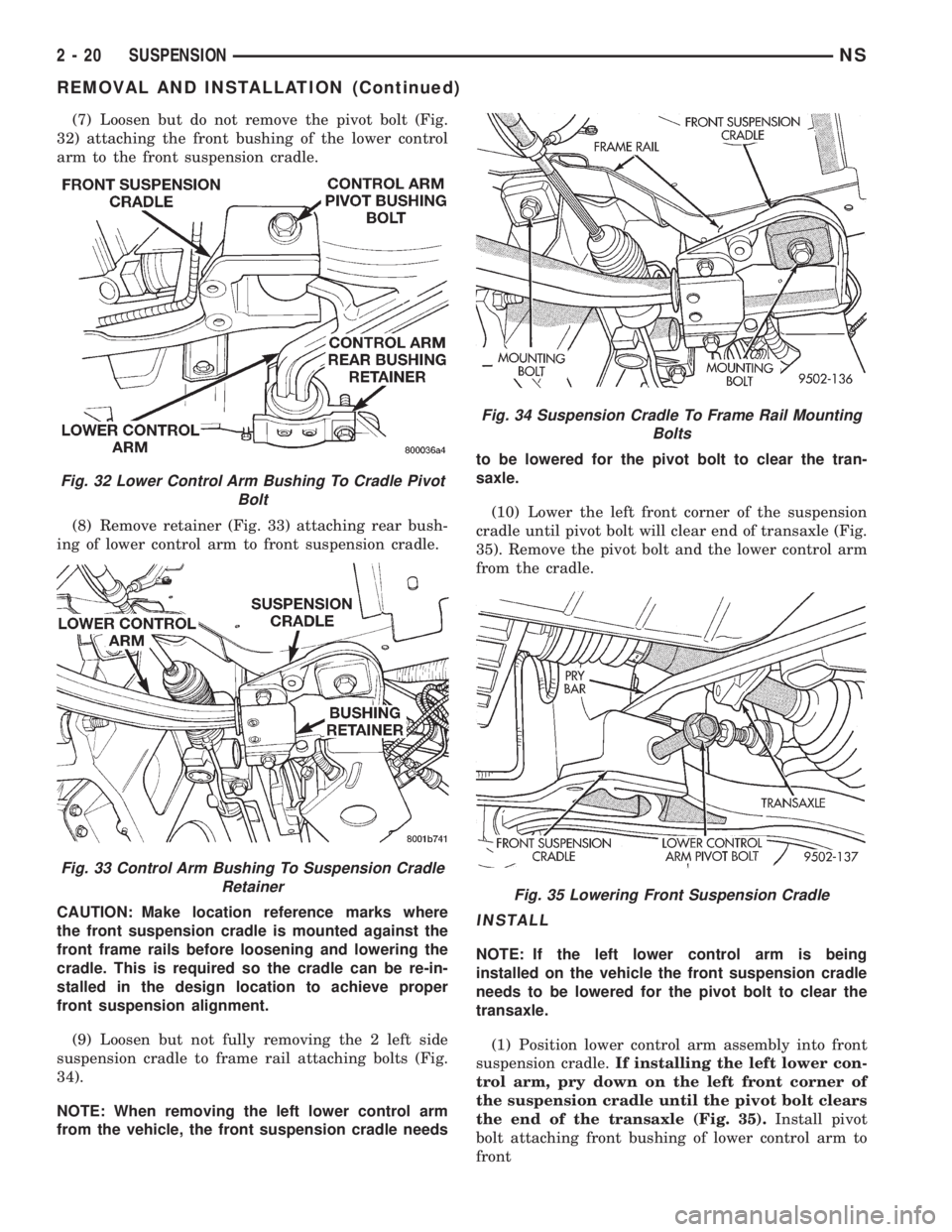
(7) Loosen but do not remove the pivot bolt (Fig.
32) attaching the front bushing of the lower control
arm to the front suspension cradle.
(8) Remove retainer (Fig. 33) attaching rear bush-
ing of lower control arm to front suspension cradle.
CAUTION: Make location reference marks where
the front suspension cradle is mounted against the
front frame rails before loosening and lowering the
cradle. This is required so the cradle can be re-in-
stalled in the design location to achieve proper
front suspension alignment.
(9) Loosen but not fully removing the 2 left side
suspension cradle to frame rail attaching bolts (Fig.
34).
NOTE: When removing the left lower control arm
from the vehicle, the front suspension cradle needsto be lowered for the pivot bolt to clear the tran-
saxle.
(10) Lower the left front corner of the suspension
cradle until pivot bolt will clear end of transaxle (Fig.
35). Remove the pivot bolt and the lower control arm
from the cradle.
INSTALL
NOTE: If the left lower control arm is being
installed on the vehicle the front suspension cradle
needs to be lowered for the pivot bolt to clear the
transaxle.
(1) Position lower control arm assembly into front
suspension cradle.If installing the left lower con-
trol arm, pry down on the left front corner of
the suspension cradle until the pivot bolt clears
the end of the transaxle (Fig. 35).Install pivot
bolt attaching front bushing of lower control arm to
front
Fig. 32 Lower Control Arm Bushing To Cradle Pivot
Bolt
Fig. 33 Control Arm Bushing To Suspension Cradle
Retainer
Fig. 34 Suspension Cradle To Frame Rail Mounting
Bolts
Fig. 35 Lowering Front Suspension Cradle
2 - 20 SUSPENSIONNS
REMOVAL AND INSTALLATION (Continued)
Page 53 of 1938
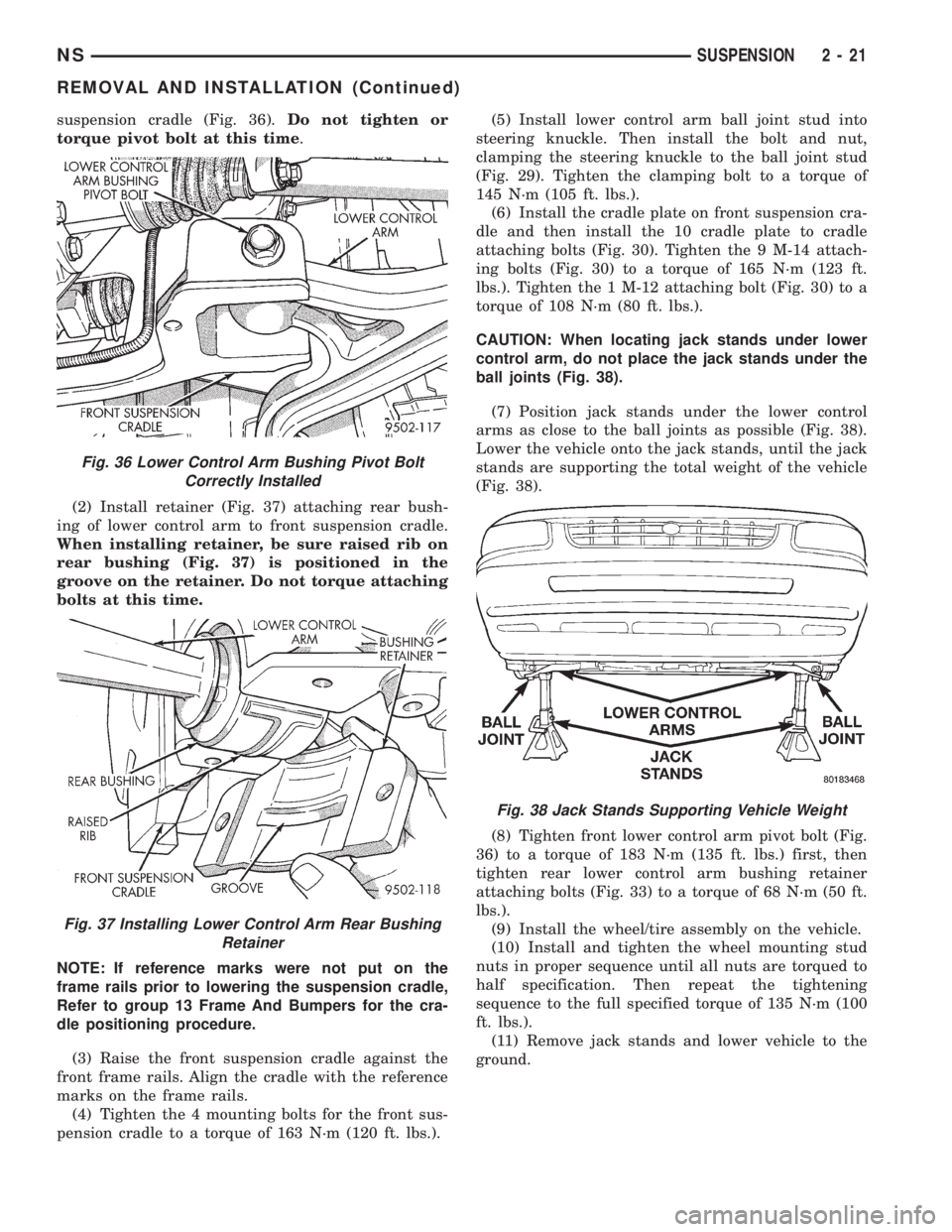
suspension cradle (Fig. 36).Do not tighten or
torque pivot bolt at this time.
(2) Install retainer (Fig. 37) attaching rear bush-
ing of lower control arm to front suspension cradle.
When installing retainer, be sure raised rib on
rear bushing (Fig. 37) is positioned in the
groove on the retainer. Do not torque attaching
bolts at this time.
NOTE: If reference marks were not put on the
frame rails prior to lowering the suspension cradle,
Refer to group 13 Frame And Bumpers for the cra-
dle positioning procedure.
(3) Raise the front suspension cradle against the
front frame rails. Align the cradle with the reference
marks on the frame rails.
(4) Tighten the 4 mounting bolts for the front sus-
pension cradle to a torque of 163 N´m (120 ft. lbs.).(5) Install lower control arm ball joint stud into
steering knuckle. Then install the bolt and nut,
clamping the steering knuckle to the ball joint stud
(Fig. 29). Tighten the clamping bolt to a torque of
145 N´m (105 ft. lbs.).
(6) Install the cradle plate on front suspension cra-
dle and then install the 10 cradle plate to cradle
attaching bolts (Fig. 30). Tighten the 9 M-14 attach-
ing bolts (Fig. 30) to a torque of 165 N´m (123 ft.
lbs.). Tighten the 1 M-12 attaching bolt (Fig. 30) to a
torque of 108 N´m (80 ft. lbs.).
CAUTION: When locating jack stands under lower
control arm, do not place the jack stands under the
ball joints (Fig. 38).
(7) Position jack stands under the lower control
arms as close to the ball joints as possible (Fig. 38).
Lower the vehicle onto the jack stands, until the jack
stands are supporting the total weight of the vehicle
(Fig. 38).
(8) Tighten front lower control arm pivot bolt (Fig.
36) to a torque of 183 N´m (135 ft. lbs.) first, then
tighten rear lower control arm bushing retainer
attaching bolts (Fig. 33) to a torque of 68 N´m (50 ft.
lbs.).
(9) Install the wheel/tire assembly on the vehicle.
(10) Install and tighten the wheel mounting stud
nuts in proper sequence until all nuts are torqued to
half specification. Then repeat the tightening
sequence to the full specified torque of 135 N´m (100
ft. lbs.).
(11) Remove jack stands and lower vehicle to the
ground.
Fig. 36 Lower Control Arm Bushing Pivot Bolt
Correctly Installed
Fig. 37 Installing Lower Control Arm Rear Bushing
Retainer
Fig. 38 Jack Stands Supporting Vehicle Weight
NSSUSPENSION 2 - 21
REMOVAL AND INSTALLATION (Continued)
Page 54 of 1938
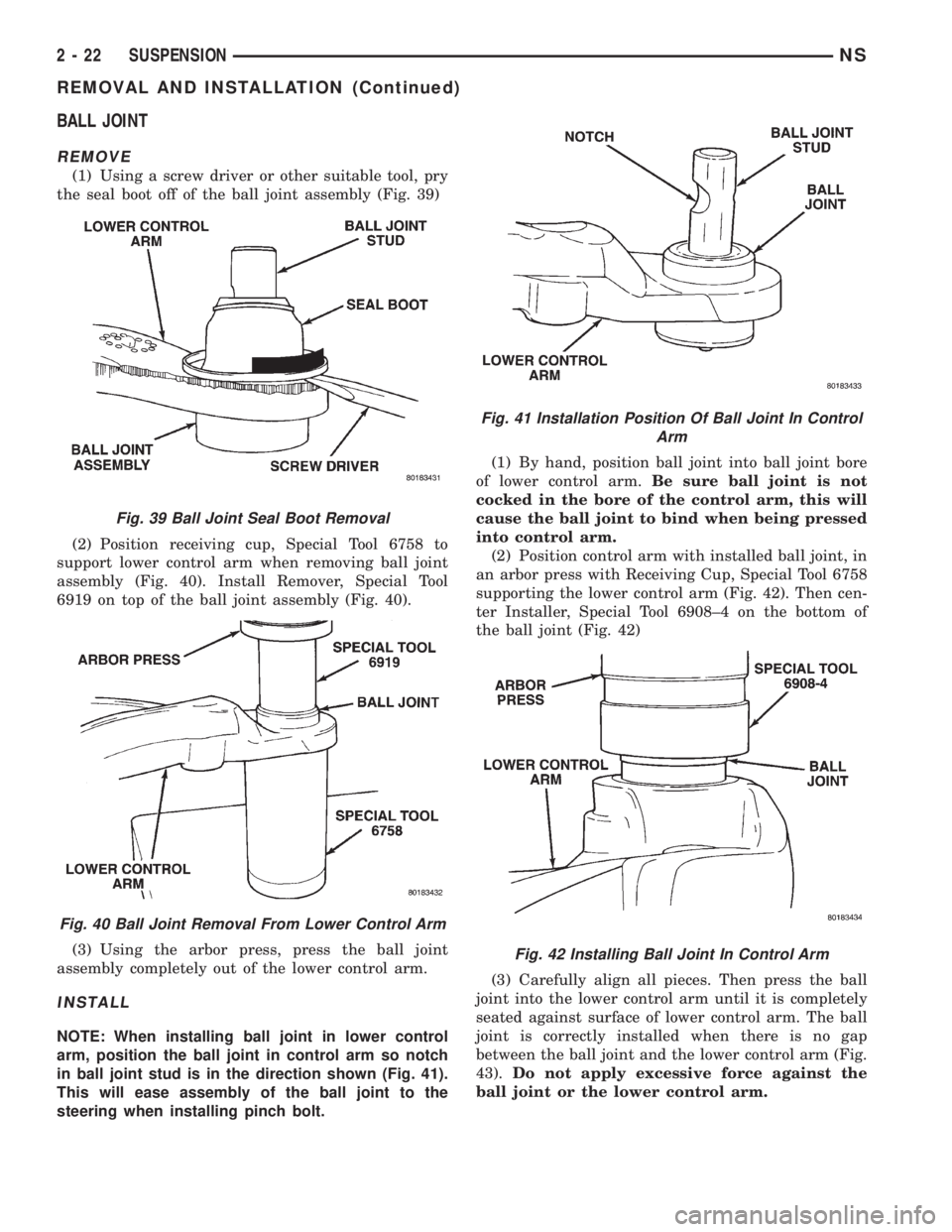
BALL JOINT
REMOVE
(1) Using a screw driver or other suitable tool, pry
the seal boot off of the ball joint assembly (Fig. 39)
(2) Position receiving cup, Special Tool 6758 to
support lower control arm when removing ball joint
assembly (Fig. 40). Install Remover, Special Tool
6919 on top of the ball joint assembly (Fig. 40).
(3) Using the arbor press, press the ball joint
assembly completely out of the lower control arm.
INSTALL
NOTE: When installing ball joint in lower control
arm, position the ball joint in control arm so notch
in ball joint stud is in the direction shown (Fig. 41).
This will ease assembly of the ball joint to the
steering when installing pinch bolt.(1) By hand, position ball joint into ball joint bore
of lower control arm.Be sure ball joint is not
cocked in the bore of the control arm, this will
cause the ball joint to bind when being pressed
into control arm.
(2) Position control arm with installed ball joint, in
an arbor press with Receiving Cup, Special Tool 6758
supporting the lower control arm (Fig. 42). Then cen-
ter Installer, Special Tool 6908±4 on the bottom of
the ball joint (Fig. 42)
(3) Carefully align all pieces. Then press the ball
joint into the lower control arm until it is completely
seated against surface of lower control arm. The ball
joint is correctly installed when there is no gap
between the ball joint and the lower control arm (Fig.
43).Do not apply excessive force against the
ball joint or the lower control arm.
Fig. 39 Ball Joint Seal Boot Removal
Fig. 40 Ball Joint Removal From Lower Control Arm
Fig. 41 Installation Position Of Ball Joint In Control
Arm
Fig. 42 Installing Ball Joint In Control Arm
2 - 22 SUSPENSIONNS
REMOVAL AND INSTALLATION (Continued)
Page 55 of 1938
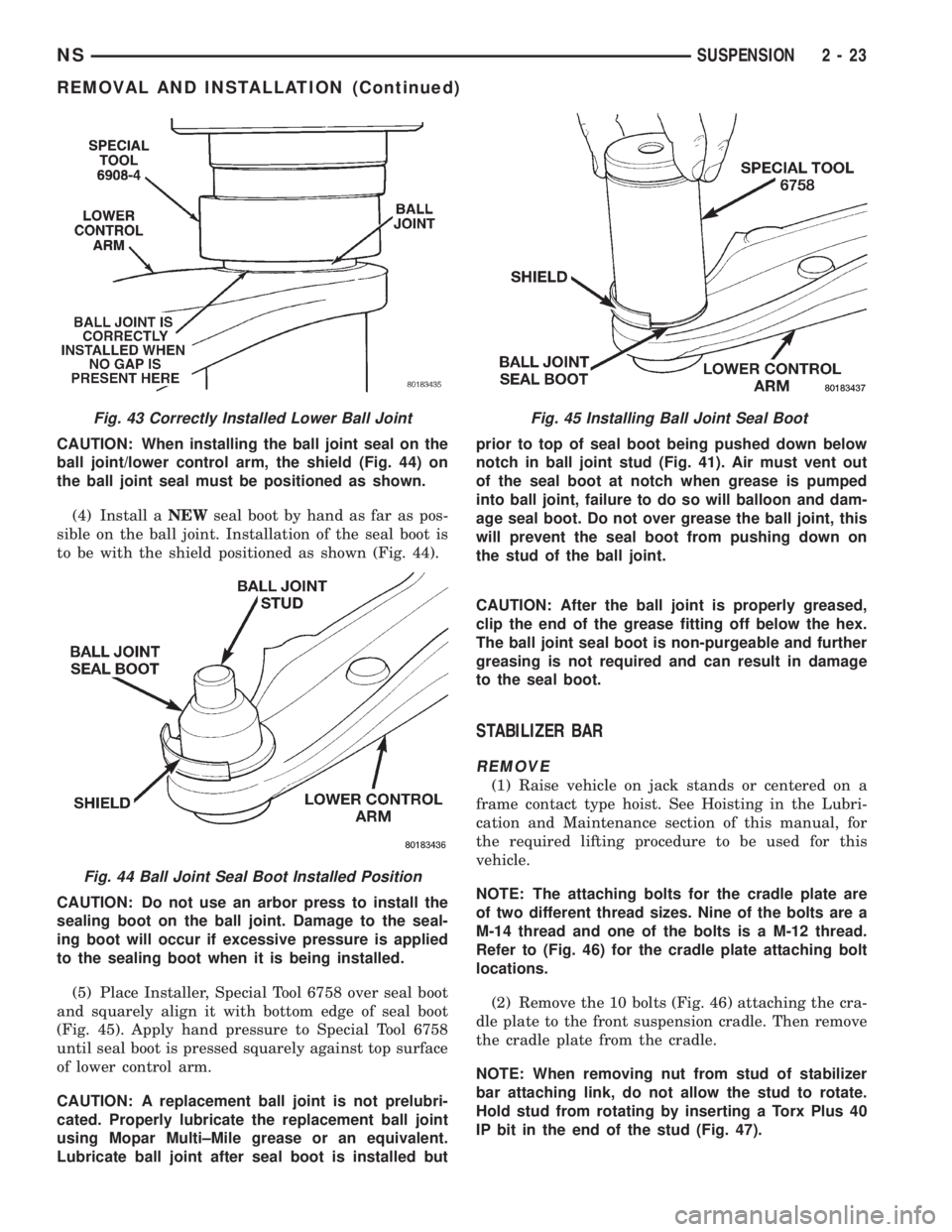
CAUTION: When installing the ball joint seal on the
ball joint/lower control arm, the shield (Fig. 44) on
the ball joint seal must be positioned as shown.
(4) Install aNEWseal boot by hand as far as pos-
sible on the ball joint. Installation of the seal boot is
to be with the shield positioned as shown (Fig. 44).
CAUTION: Do not use an arbor press to install the
sealing boot on the ball joint. Damage to the seal-
ing boot will occur if excessive pressure is applied
to the sealing boot when it is being installed.
(5) Place Installer, Special Tool 6758 over seal boot
and squarely align it with bottom edge of seal boot
(Fig. 45). Apply hand pressure to Special Tool 6758
until seal boot is pressed squarely against top surface
of lower control arm.
CAUTION: A replacement ball joint is not prelubri-
cated. Properly lubricate the replacement ball joint
using Mopar Multi±Mile grease or an equivalent.
Lubricate ball joint after seal boot is installed butprior to top of seal boot being pushed down below
notch in ball joint stud (Fig. 41). Air must vent out
of the seal boot at notch when grease is pumped
into ball joint, failure to do so will balloon and dam-
age seal boot. Do not over grease the ball joint, this
will prevent the seal boot from pushing down on
the stud of the ball joint.
CAUTION: After the ball joint is properly greased,
clip the end of the grease fitting off below the hex.
The ball joint seal boot is non-purgeable and further
greasing is not required and can result in damage
to the seal boot.
STABILIZER BAR
REMOVE
(1) Raise vehicle on jack stands or centered on a
frame contact type hoist. See Hoisting in the Lubri-
cation and Maintenance section of this manual, for
the required lifting procedure to be used for this
vehicle.
NOTE: The attaching bolts for the cradle plate are
of two different thread sizes. Nine of the bolts are a
M-14 thread and one of the bolts is a M-12 thread.
Refer to (Fig. 46) for the cradle plate attaching bolt
locations.
(2) Remove the 10 bolts (Fig. 46) attaching the cra-
dle plate to the front suspension cradle. Then remove
the cradle plate from the cradle.
NOTE: When removing nut from stud of stabilizer
bar attaching link, do not allow the stud to rotate.
Hold stud from rotating by inserting a Torx Plus 40
IP bit in the end of the stud (Fig. 47).
Fig. 43 Correctly Installed Lower Ball Joint
Fig. 44 Ball Joint Seal Boot Installed Position
Fig. 45 Installing Ball Joint Seal Boot
NSSUSPENSION 2 - 23
REMOVAL AND INSTALLATION (Continued)
Page 56 of 1938

(3) Remove the nuts (Fig. 47) attaching the stabi-
lizer bar attaching links to the stabilizer bar. Then
remove the attaching links from the stabilizer bar.
(4) Remove the stabilizer bar bushing retainers
from the front suspension cradle (Fig. 48).
(5) Remove the stabilizer bar and bushings as an
assembly from the front suspension cradle.
INSTALL
(1) If the stabilizer bar to front suspension cradle
bushings require replacement at time of inspection,
install new bushings before installing stabilizer bar.
Bushings are replaced by opening slit on bushings
and peeling them off stabilizer bar. Install new bush-
ings on stabilizer bar by spreading bushing at slit
and forcing them on the stabilizer bar.Bushings
must be installed on stabilizer bar so slit in
bushing will be facing toward the rear of vehi-
cle with the square corner toward the ground,when the stabilizer bar is installed on the vehi-
cle (Fig. 49).
(2) Position stabilizer bar into front suspension
cradle so stabilizer bar bushings are aligned with
depressions in cradle. Install stabilizer bar bushing
retainers onto crossmember aligning raised bead on
retainer with cutouts in bushings (Fig. 50).Do not
tighten Stabilizer bar bushing retainers at this
time.
(3) Check position of the stabilizer bar in the front
suspension cradle. The center of the curved section of
the stabilizer bar must be aligned with the raised
line in the center of the front suspension cradle (Fig.
51).
(4) Align holes in stabilizer bar with attaching link
assemblies. Install the stabilizer bar attaching links
into the stabilizer bar and install the attaching nuts
(Fig. 47).
Fig. 46 Cradle Plate And Mounting Bolts
Fig. 47 Stabilizer Bar Link Attachment To Stabilizer
Bar
Fig. 48 Front Stabilizer Bar Bushing Retainers
Fig. 49 Correctly Installed Stabilizer Bar To Cradle
Bushing
2 - 24 SUSPENSIONNS
REMOVAL AND INSTALLATION (Continued)
Page 57 of 1938
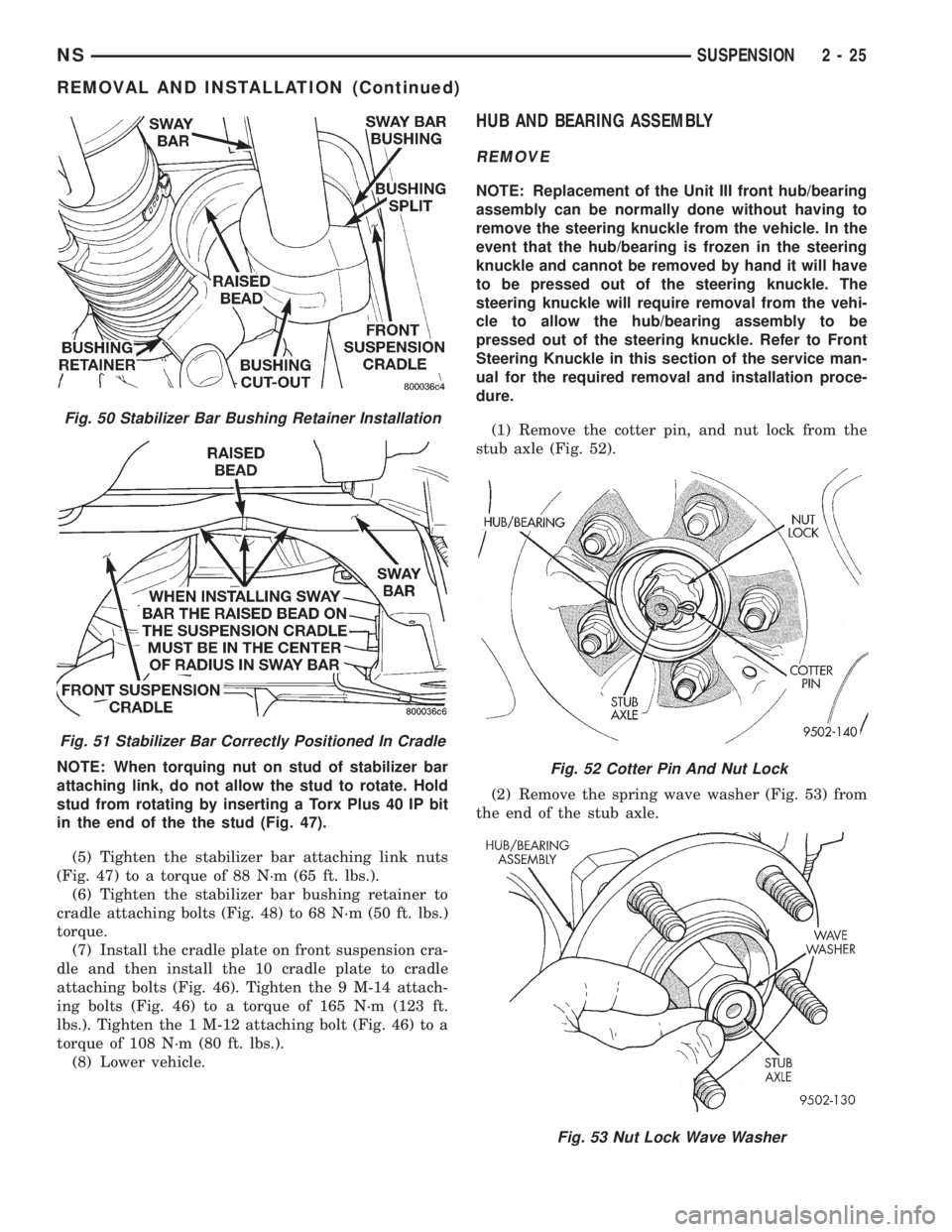
NOTE: When torquing nut on stud of stabilizer bar
attaching link, do not allow the stud to rotate. Hold
stud from rotating by inserting a Torx Plus 40 IP bit
in the end of the the stud (Fig. 47).
(5) Tighten the stabilizer bar attaching link nuts
(Fig. 47) to a torque of 88 N´m (65 ft. lbs.).
(6) Tighten the stabilizer bar bushing retainer to
cradle attaching bolts (Fig. 48) to 68 N´m (50 ft. lbs.)
torque.
(7) Install the cradle plate on front suspension cra-
dle and then install the 10 cradle plate to cradle
attaching bolts (Fig. 46). Tighten the 9 M-14 attach-
ing bolts (Fig. 46) to a torque of 165 N´m (123 ft.
lbs.). Tighten the 1 M-12 attaching bolt (Fig. 46) to a
torque of 108 N´m (80 ft. lbs.).
(8) Lower vehicle.
HUB AND BEARING ASSEMBLY
REMOVE
NOTE: Replacement of the Unit III front hub/bearing
assembly can be normally done without having to
remove the steering knuckle from the vehicle. In the
event that the hub/bearing is frozen in the steering
knuckle and cannot be removed by hand it will have
to be pressed out of the steering knuckle. The
steering knuckle will require removal from the vehi-
cle to allow the hub/bearing assembly to be
pressed out of the steering knuckle. Refer to Front
Steering Knuckle in this section of the service man-
ual for the required removal and installation proce-
dure.
(1) Remove the cotter pin, and nut lock from the
stub axle (Fig. 52).
(2) Remove the spring wave washer (Fig. 53) from
the end of the stub axle.
Fig. 50 Stabilizer Bar Bushing Retainer Installation
Fig. 51 Stabilizer Bar Correctly Positioned In Cradle
Fig. 52 Cotter Pin And Nut Lock
Fig. 53 Nut Lock Wave Washer
NSSUSPENSION 2 - 25
REMOVAL AND INSTALLATION (Continued)
Page 58 of 1938
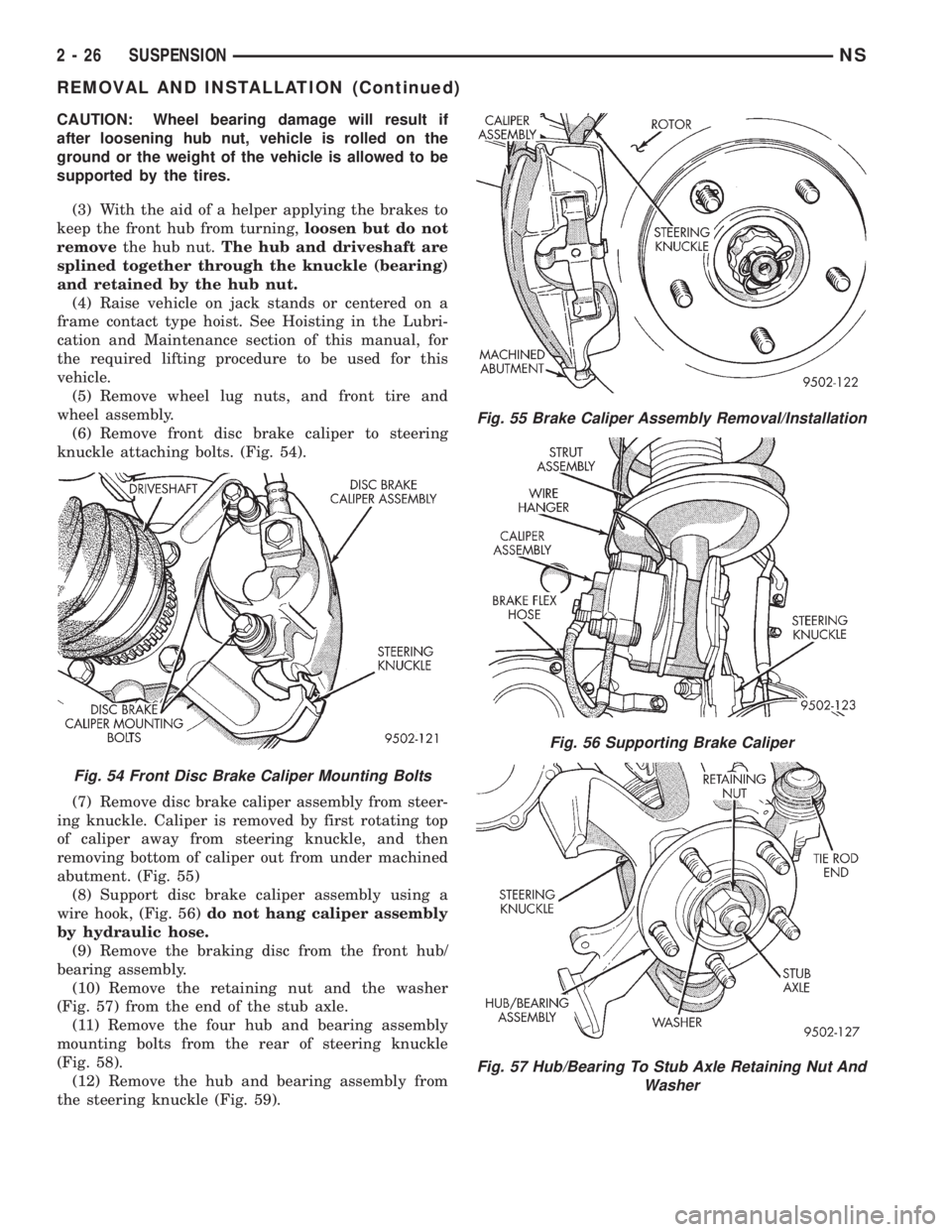
CAUTION: Wheel bearing damage will result if
after loosening hub nut, vehicle is rolled on the
ground or the weight of the vehicle is allowed to be
supported by the tires.
(3) With the aid of a helper applying the brakes to
keep the front hub from turning,loosen but do not
removethe hub nut.The hub and driveshaft are
splined together through the knuckle (bearing)
and retained by the hub nut.
(4) Raise vehicle on jack stands or centered on a
frame contact type hoist. See Hoisting in the Lubri-
cation and Maintenance section of this manual, for
the required lifting procedure to be used for this
vehicle.
(5) Remove wheel lug nuts, and front tire and
wheel assembly.
(6) Remove front disc brake caliper to steering
knuckle attaching bolts. (Fig. 54).
(7) Remove disc brake caliper assembly from steer-
ing knuckle. Caliper is removed by first rotating top
of caliper away from steering knuckle, and then
removing bottom of caliper out from under machined
abutment. (Fig. 55)
(8) Support disc brake caliper assembly using a
wire hook, (Fig. 56)do not hang caliper assembly
by hydraulic hose.
(9) Remove the braking disc from the front hub/
bearing assembly.
(10) Remove the retaining nut and the washer
(Fig. 57) from the end of the stub axle.
(11) Remove the four hub and bearing assembly
mounting bolts from the rear of steering knuckle
(Fig. 58).
(12) Remove the hub and bearing assembly from
the steering knuckle (Fig. 59).
Fig. 54 Front Disc Brake Caliper Mounting Bolts
Fig. 55 Brake Caliper Assembly Removal/Installation
Fig. 56 Supporting Brake Caliper
Fig. 57 Hub/Bearing To Stub Axle Retaining Nut And
Washer
2 - 26 SUSPENSIONNS
REMOVAL AND INSTALLATION (Continued)
Page 59 of 1938
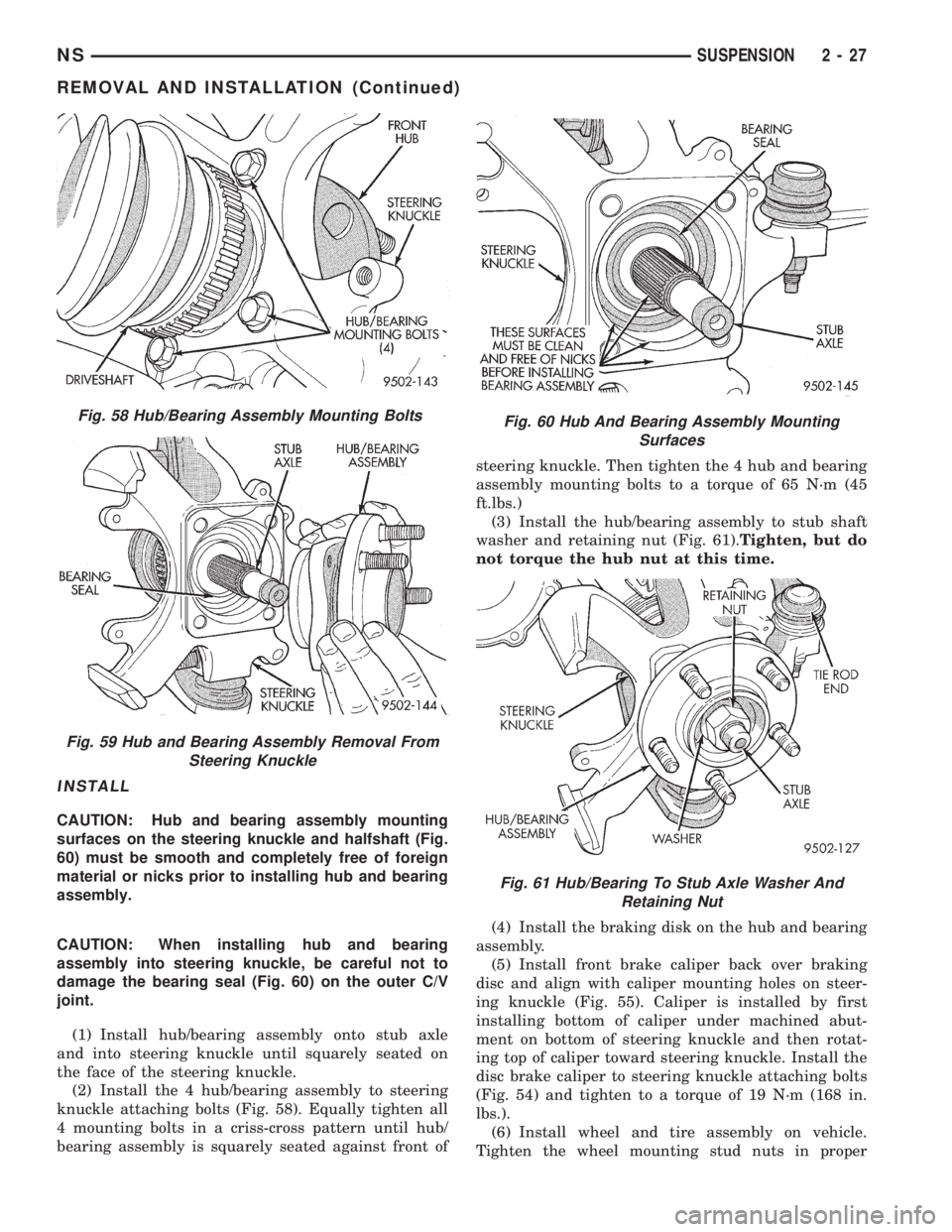
INSTALL
CAUTION: Hub and bearing assembly mounting
surfaces on the steering knuckle and halfshaft (Fig.
60) must be smooth and completely free of foreign
material or nicks prior to installing hub and bearing
assembly.
CAUTION: When installing hub and bearing
assembly into steering knuckle, be careful not to
damage the bearing seal (Fig. 60) on the outer C/V
joint.
(1) Install hub/bearing assembly onto stub axle
and into steering knuckle until squarely seated on
the face of the steering knuckle.
(2) Install the 4 hub/bearing assembly to steering
knuckle attaching bolts (Fig. 58). Equally tighten all
4 mounting bolts in a criss-cross pattern until hub/
bearing assembly is squarely seated against front ofsteering knuckle. Then tighten the 4 hub and bearing
assembly mounting bolts to a torque of 65 N´m (45
ft.lbs.)
(3) Install the hub/bearing assembly to stub shaft
washer and retaining nut (Fig. 61).Tighten, but do
not torque the hub nut at this time.
(4) Install the braking disk on the hub and bearing
assembly.
(5) Install front brake caliper back over braking
disc and align with caliper mounting holes on steer-
ing knuckle (Fig. 55). Caliper is installed by first
installing bottom of caliper under machined abut-
ment on bottom of steering knuckle and then rotat-
ing top of caliper toward steering knuckle. Install the
disc brake caliper to steering knuckle attaching bolts
(Fig. 54) and tighten to a torque of 19 N´m (168 in.
lbs.).
(6) Install wheel and tire assembly on vehicle.
Tighten the wheel mounting stud nuts in proper
Fig. 58 Hub/Bearing Assembly Mounting Bolts
Fig. 59 Hub and Bearing Assembly Removal From
Steering Knuckle
Fig. 60 Hub And Bearing Assembly Mounting
Surfaces
Fig. 61 Hub/Bearing To Stub Axle Washer And
Retaining Nut
NSSUSPENSION 2 - 27
REMOVAL AND INSTALLATION (Continued)
Page 60 of 1938
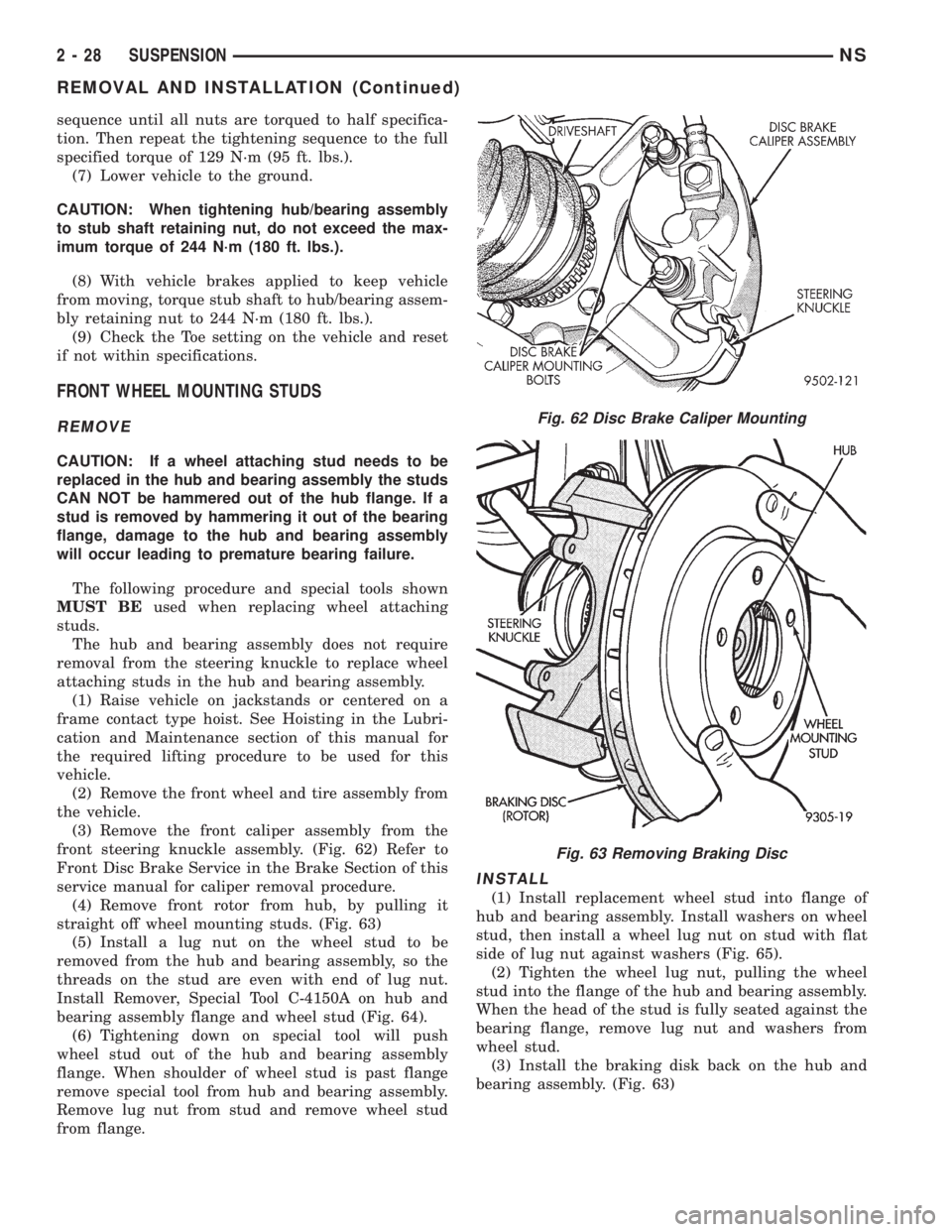
sequence until all nuts are torqued to half specifica-
tion. Then repeat the tightening sequence to the full
specified torque of 129 N´m (95 ft. lbs.).
(7) Lower vehicle to the ground.
CAUTION: When tightening hub/bearing assembly
to stub shaft retaining nut, do not exceed the max-
imum torque of 244 N´m (180 ft. lbs.).
(8) With vehicle brakes applied to keep vehicle
from moving, torque stub shaft to hub/bearing assem-
bly retaining nut to 244 N´m (180 ft. lbs.).
(9) Check the Toe setting on the vehicle and reset
if not within specifications.
FRONT WHEEL MOUNTING STUDS
REMOVE
CAUTION: If a wheel attaching stud needs to be
replaced in the hub and bearing assembly the studs
CAN NOT be hammered out of the hub flange. If a
stud is removed by hammering it out of the bearing
flange, damage to the hub and bearing assembly
will occur leading to premature bearing failure.
The following procedure and special tools shown
MUST BEused when replacing wheel attaching
studs.
The hub and bearing assembly does not require
removal from the steering knuckle to replace wheel
attaching studs in the hub and bearing assembly.
(1) Raise vehicle on jackstands or centered on a
frame contact type hoist. See Hoisting in the Lubri-
cation and Maintenance section of this manual for
the required lifting procedure to be used for this
vehicle.
(2) Remove the front wheel and tire assembly from
the vehicle.
(3) Remove the front caliper assembly from the
front steering knuckle assembly. (Fig. 62) Refer to
Front Disc Brake Service in the Brake Section of this
service manual for caliper removal procedure.
(4) Remove front rotor from hub, by pulling it
straight off wheel mounting studs. (Fig. 63)
(5) Install a lug nut on the wheel stud to be
removed from the hub and bearing assembly, so the
threads on the stud are even with end of lug nut.
Install Remover, Special Tool C-4150A on hub and
bearing assembly flange and wheel stud (Fig. 64).
(6) Tightening down on special tool will push
wheel stud out of the hub and bearing assembly
flange. When shoulder of wheel stud is past flange
remove special tool from hub and bearing assembly.
Remove lug nut from stud and remove wheel stud
from flange.
INSTALL
(1) Install replacement wheel stud into flange of
hub and bearing assembly. Install washers on wheel
stud, then install a wheel lug nut on stud with flat
side of lug nut against washers (Fig. 65).
(2) Tighten the wheel lug nut, pulling the wheel
stud into the flange of the hub and bearing assembly.
When the head of the stud is fully seated against the
bearing flange, remove lug nut and washers from
wheel stud.
(3) Install the braking disk back on the hub and
bearing assembly. (Fig. 63)
Fig. 62 Disc Brake Caliper Mounting
Fig. 63 Removing Braking Disc
2 - 28 SUSPENSIONNS
REMOVAL AND INSTALLATION (Continued)